#televisionmusic
Explore tagged Tumblr posts
Text
Roundtable 2: We Are Lady Parts

We Are Lady Parts is a currently-running British sitcom following the formation of and development of a band named Lady Parts made up entirely of Muslim women. Upon its release, the series was met with a positive critical reception and lauded for its complex representations of Muslim women (it passed the Riz test with flying colors).
For the Roundtable, I analyzed the first episode of the show, titled “Play Something,” which depicts the band’s formation as Amina, a shy PhD student and guitar teacher, meets the struggling band “Lady Parts” and must attempt to overcome her crippling stage fright in order to join.
How does the series use dual-focus narrative as a strategic storytelling tool beyond heteronormative romantic pairings?
Beyond heteronormative romantic pairings, this episode employs a dual-focus narrative as a strategy for storytelling in its depictions of Amina and Lady Parts as two disparate yet intrinsically-tied entities. The show “Lady Parts” is a representation and exploration of coming of age for five Muslim women in their twenty-somethings. To borrow from Raymond Knapp in the reading from Robyn Stilwell, the show is “really about” self-assured-ness and confidence that comes from embracing the complexities that contribute to our identities. As such, the show explores this dual-focus narrative by placing Amina’s storyline in conversation with that of Lady Parts. The members of Lady Parts are funny, confident, punk, messy while Amina is painfully shy and struggling to express herself. This dual-focus is introduced in the first episode and continues to be fleshed out throughout the rest of the series. Because of this, the parallelism of the serialized dual-focus narrative of Lady Parts centers the emotional development of its female characters rather than heteronormative romantic pairing. This provides the series with space to flesh out the members of Lady Parts as one body and as individuals alike.
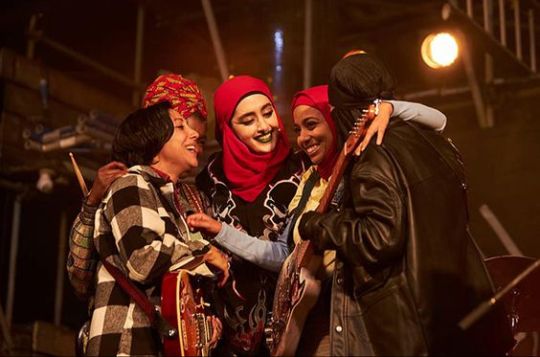
What are the “inevitable” couplings within the series and how are they accentuated through “cinematic” similarities and contrasts?
This episode opens on a scene in which Amina and her parents are meeting a potential suitor. It is here that we first see the complexities of her characterization as her parents begin to spill to her suitor and his conservative parents about Amina’s guitar skills and her stage fright which, according to her mother, “induces diarrhea and vomiting”, embarrassing Amina. Over voiceover from Amina, we learn that she has been on a self-motivated quest to find a husband – a quest that, per her admission, has been going “fairly disastrously”; however, through this scene, we are also introduced to her musical ability and personal struggle with performing. The scene concludes with voiceover narration, in which Amina says to the audience, “Little did I know things were about to change”.
This places Amina’s personal story within that of the preexisting body of Lady Parts and creates an “inevitable” coupling between the two storylines. Immediately following the scene introducing Amina, we are introduced to Lady Parts. The band is seen practicing one of their songs until one of the members, Saira, stops out of frustration, claiming, “We need a lead guitarist”. The group proceeds to discuss the merits of adding a fifth member to the band, eventually deciding to hold auditions for a lead guitarist.
This recalls and parallels the scene before. Throughout this first episode, “We Are Lady Parts” uses pacing to place the storylines of Amina and Lady Parts in conversation with one another. A scene from one storyline will be followed by a similar scene within the other storyline. This creates a tempo of inevitability which the dual-focus narrative follows until the end of the episode – when Amina and Lady Parts collide.
youtube
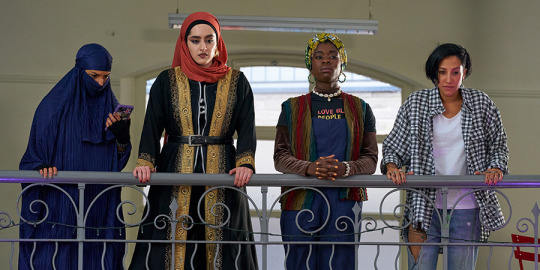
How does the series use musical numbers within and beyond the narrative world to replicate fairy tale, backstage, or folk musicals?
We Are Lady Parts uses its musical numbers to embody the traditions of the backstage musical while subverting it. The music is primarily diegetic and as such it is typically performed by Lady Parts. Through the use of music and performance, the audience is able to become familiarized with Lady Parts’ post-punk “sound”. Additionally, through musical performance, the series further characterizes the dynamics and tensions within the band and the individuals which make it up. Lady Parts doesn’t just fit itself neatly within the catalogue of preexisting backstage musicals, rather it takes influence from the traditional backstage musical while subverting it through its music and characterization. The songs in the show are funny and pointed, and through their punk sentiment, they challenge stereotypes and Western depictions of Muslim women.
youtube
youtube
15 notes
·
View notes
Text
Julie and the Phantoms

Julie and the Phantoms (JATP) is a one-season-wonder musical comedy series created by Dan Cross and David Hoge, with the notable executive production of Kenny Ortega (HSM, Descendants, Cheetah Girls, etc.). With the recent passing of her mom, Julie gets kicked out of her school’s prestigious music program for being unable to emotionally perform. When looking through her mom’s things she stumbles across a “Sunset Curve” CD and accidentally welcomes the “phantoms” into her world. Luke, Alex, and Reggie, AKA “Sunset Curve”, were a boyband from the 80s that died prematurely. After hearing Julie sing and realizing they can be seen when they play their music, they form a new band, Julie and the Phantoms.
youtube
youtube
While the show does employ a dual-focus narrative for the heteronormative pairing of Julie and Luke (never “resolved” because (a) the actor who plays Julie is a minor and Luke is not and (b) the creators were hoping for a second season, possibly with a follow-through for the more age-appropriate love interest, Nick) they also use it for the sort of rivalry that Robynn Stilwell discusses in Smash. Episode six, “Finally Free”, presents the culmination of the competition between Julie and her ex-best friend, Carrie, in their back-to-back musical performances. Carrie and her band, or rather, backup dancers, perform “All Eyes on Me”, a me-myself-and-I song dedicated to Carrie’s greatness and high social status. Though their performance is technically clean and impressive, it also solidifies a class and character difference between Carries and Julie: Carrie’s dad is a rich music executive and she is, in every way, a quintessential Disney-fied mean girl. Julie is by no means low-income, but her single-parent multi-child household and the recent loss of her mother do not position her as privileged either. Notably, Carrie is blonde and white and Julie is multiracial and brown. Though never directly stated, one may argue that this intersectional identity that Julie has is the “other cultural aspect” (Stilwell 384) used to provide deeper meaning for the show. Julie and the Phantoms perform “Finally Free” an uplifting song up to interpretation: free from grief, from judgment, from fear. All of the songs performed by Julie and the Sunset Curve boys stand out from Carrie’s due to their emotional depth and interpersonal interaction: Julie interacts with her bandmates, while Carrie’s are solely there for show.


youtube
The “inevitable coupling” in this series happens through an inevitable, albeit unconfirmed, grouping. In the first episode, we watch Sunset Curve interact with a waitress named Rose, to whom they gift a CD and t-shirt. As they exit the venue, Luke comments about how big their band is going to be, how much that waitress’s compliments resonated with him, and how excited he is to play the Orpheum. Minutes later when Julie’s looking through her mom’s things she stumbles across a Sunset Curve CD and t-shirt. We’re never told Julie’s mom’s name in the show, but given their physical similarities and how much Julie associates her with flowers, it’s widely considered that Rose was, in fact, Julie’s mom. In the final episode, Julie and the Phantoms perform at the Orpheum, fulfilling the band’s dream, and one of her mom’s. Almost every song the band sings together includes a duet section for Julie and Luke; singing/performing is where most of their connection and relationship advancement comes from. As Stilwell concludes, the creators employ duets and musical cinema to “create character relationships that would take longer to establish through normal exposition like dialogue...” (393).

With the exceptions of “Unsaid Emily” and “Perfect Harmony”, every musical interlude is incorporated fully into the physical and time constraints of the series, establishing this as a backstage musical. Most of their singing/playing is in preparation for a performance or purely for practicing and jamming together. There are lots of wide shots showing the band collectively in Julie’s garage, advancing the narrative as they perform.
@theuncannyprofessoro
18 notes
·
View notes
Text
Roundtable Presentations 2: Girls5eva (2021-2022, 2024-)
Girls5eva is a television musical series created by Meredith Scardino, and executive produced by Tina Fey, Robert Carlock, and Jeff Richmond. Set in New York City, the series centers around four members of a former girl group – Dawn, Wickie, Gloria, and Summer – as they navigate the highs and lows of reuniting for a second chance at stardom. Each character grapples with personal and professional challenges while rediscovering their passion for music and friendship.

How does the series use dual-focus narrative as a strategic storytelling tool beyond heteronormative romantic pairings?
In Girls5eva, the dual-focus narrative extends beyond heteronormative romantic pairings by centering on the friendships and professional endeavors of the main characters: Dawn, Wickie, Gloria, and Summer. While romantic relationships are present, they are not the primary focus of the storyline. Instead, the series delves into the complexities of platonic bonds, familial ties, and individual growth trajectories. Each character grapples with their own struggles, aspirations, and personal journeys, contributing to a rich and inclusive portrayal of human connections beyond traditional romantic narratives. This strategic storytelling tool allows Girls5eva to explore themes of friendship, ambition, and self-discovery in a nuanced and relatable manner, resonating with a diverse audience.
2. What are the “inevitable” couplings within the series and how are they accentuated through “cinematic” similarities and contrasts?One of the inevitable couplings is between Dawn and Wickie. Their dynamic is accentuated through cinematic techniques that highlight their contrasting personalities and aspirations. Dawn, portrayed as ambitious and driven, represents the pursuit of success in the music industry, while Wickie embodies authenticity and genuine passion for music. Their friendship, though initially fraught with tension, evolves into a symbiotic relationship that adds depth to the storyline.
Throughout the series, Dawn and Wickie's interactions are characterized by moments of intimacy, vulnerability, and mutual support, which subtly hint at a deeper emotional connection. These moments are juxtaposed against their differing approaches to music and fame, creating compelling contrasts that drive the narrative forward.
As Robynn Stilwell suggests, the series interweaves these character arcs with themes of friendship and personal growth, mirroring the nuanced storytelling found in shows like "Smash" and "Nashville." Through cinematic techniques such as juxtaposition and thematic motifs, the contrasts between Dawn's drive for success and Wickie's genuine passion for music are accentuated, creating compelling interactions that resonate with viewers.

3. How does the series use musical numbers within and beyond the narrative world to replicate fairy tale, backstage, or folk musicals?
Within the narrative world of the series, musical numbers are seamlessly integrated into the storyline, often advancing the plot or providing insight into the characters' inner thoughts and motivations. These musical sequences are not merely moments of entertainment but crucial elements that deepen character development and advance the overarching narrative. For example, in Episode 8 "Separ8 Ways" in Season 1, we see Dawn express her hopes and fears within the groups potential split. This provides the audience with deeper insights into their motivations and struggles.
Beyond the narrative world, Girls5eva employs visual and thematic elements to evoke the atmosphere of backstage dramas. In episodes like "Tour Mode" and "Album Mode," we witness the behind-the-scenes drama of the entertainment industry, incorporating musical numbers to heighten tension and drama. There are choreographed dance numbers and emotionally charged vocal performances, which heighten the drama and showcase the cutthroat world of show business.

17 notes
·
View notes
Text
Roundtable presentation: Victorious
Victorious follows Tori Vega, an unassuming teenager who lands a coveted spot at Hollywood Arts High School, a prestigious performing arts school, after taking her older sister's place in a showcase. Surrounded by her talented classmates like Andre, Robbie, Jade, and Beck, Tori navigates the challenges of high school life with a focus on music, performance, and the ups and downs of artistic pursuits. The show utilizes humor, musical numbers, and a dual-focus narrative that explores not just romantic relationships, but also friendships, mentorship, and collaboration as Tori gains confidence and embraces her newfound passion for performing.

How does the series use dual-focus narrative as a strategic storytelling tool beyond heteronormative romantic pairings?
Victorious is more of a coming of age show. I think the central focus of this dual-focus narrative is mainly navigating highschool in a very competitive performing arts world, while juggling with the drama and complexities of being a teenager.
Trina and Tori’s dynamic is a prime example of this. While often played for laughs, they offer a unique dual focus on sibling rivalry and eventual support. Episodes explore the challenges of living in each other's shadows while ultimately showcasing a bond of care, even if expressed in a quirky way.
youtube
Cat and Jade’s friendship is another example. Their contrasting personalities - Cat's bubbly, seemingly innocent and dumb, and Jade's dry wit - create a dynamic that focuses on loyalty, acceptance, and navigating the intricacies of female friendship and girlhood.
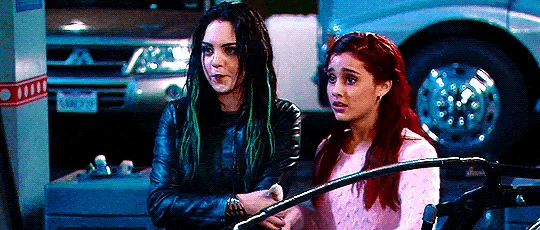
Often, the show adopts a "group focus" narrative, touching on themes of teamwork, navigating high school and the “que serás” of life after graduation. Victories at competitions, overcoming obstacles thrown their way by Sikowitz, or simply hanging out are all depicted with a group focus, fostering a sense of community and shared journey. Sikowitz, the eccentric yet insightful teacher, becomes a mentor figure for each character. The dual focus here explores themes of artistic growth, following one's passion, and overcoming self-doubt, with each character's journey receiving dedicated focus.
What are the “inevitable” couplings within the series and how are they accentuated through “cinematic” similarities and contrasts?
Beck and Jade’s love story is a classic "opposites attract" with cinematic parallels. Beck, the carefree charmer, is often contrasted with Jade's fierce and sarcastic personality. They use slow-motion moments, lingering glances, and dramatic lighting to emphasize their inevitable connection. Their contrasting personalities often lead to humorous conflicts. Jade's sharp wit clashes with Beck's laid-back demeanor, resulting in playful banter and witty exchanges. These comedic moments keep the relationship dynamic and prevent it from becoming overly sentimental. While slow-motion highlights their connection, their body language in everyday interactions can show their contrasting comfort levels. Beck might have a more open posture, while Jade might have crossed arms or a guarded stance, hinting at their underlying feelings and insecurities. Although, somehow, they seem to not be able to stay away from each other!

How does the series use musical numbers within and beyond the narrative world to replicate fairy tale, backstage, or folk musicals?
Diegetic musical numbers like "Freak the Freak Out" blur the lines between reality and the fictional performance. The song takes place during a moment in which Tori wants to prove herself and others that she is talented, in some way, it showcases her anxieties and at the same time, her confidence as she performs for the karaoke bar's crowd. On the contrary, Acoustic numbers like "You Don't Know Me" performed by Jade mirror the folk musical style, emphasizing personal growth and self-discovery. This stripped-down style allows for a more intimate portrayal of her character’s emotions and vulnerabilities, as she is often only portrayed as the punk, emo teenager with no feelings.
youtube
18 notes
·
View notes
Text
Queens (2021-2022) by Zahir McGhee
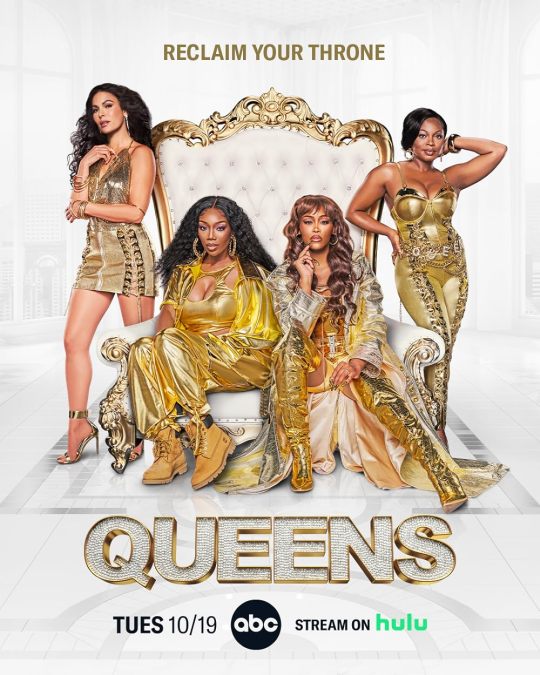
In Zahir McGhee's musical TV show, Queens (2021-2022), follows the story of four women in their 40s previously in a famous hip-hop group together, reuniting to regain fame. Throughout the first two episodes, we see the show rehashing their past and the changes of roles in each of their lives that creates individual hardship, but finding comfort and vulnerability within their group.
How does the series use dual-focus narrative as a strategic storytelling tool beyond heteronormative romantic pairings?
Throughout the first episode, we are shown each member of the group and their current situations outside of their past. Brianna, or Professor Sex, is a mother of five and recently caught her husband cheating on her with a student of his. On top of that, he was diagnosed with cancer and had to get surgery, leaving Brianna having to take care of him for the sake of her children. Jill, or Jill the Thrill, is struggling to find coexistence with her sexuality and religion, as she has been having an affair with a woman that she is in love with and is having a hard time confronting her husband. Naomi, or Xplicit Lyrics, continues to chase her dreams of making music whilst trying to balance being a present mother for her daughter. In connection is her past complicated relationship with the group’s manager, Eric, who chose to be with Valeria, or Butter Pecan.
youtube
At the end performance at the BET, the women performed for the first time on stage together since they broke up, as each of their rap parts were in regards to their personal and romantic relationships. The use of rap as a way to create both a powerful and vulnerable moment for them as friends and as women facing the hardships of their reality. Especially when rap and hip-hop is a male dominated genre, the women's ability to use rap as a way to gain control and power over their own bodies and terms of their own lives changes the narrative to show themes of black femininity and the toxicity of the music industry towards women of color.
What are the “inevitable” couplings within the series and how are they accentuated through “cinematic” similarities and contrasts?
The use of flashbacks and song as a way to cinematically explain the relationships between characters is embedded throughout the series. Although there are romantic relationships in the show, the relationship between the women and their loved ones is stands out, as there connection instills a comfortable vulnerability within conversations had and through song.
youtube
Before the BET performance, Naomi sings a beautiful ballad in regards to her relationship with her daughter. But, this song expands to the women facing their issues through confrontation and self-reflection. Through editing, the song is paired with all the situations at hand using visuals that go along with the narrative and feelings of each character. Although this does not go along the traditional "inevitable" couple, this does show the strong connections of the women and their own journey of fully gaining independence from their controlling past.
How does the series use musical numbers within and beyond the narrative world to fairytale, backstage, and musical?
The film's modern time does not take away from the escaping reality that musicals give. The use of song, especially within Naomi who is still chasing her dreams of being a folk solo artist, but is faced with obstacles due to the sexist and racist environment of the music industry. After meeting with a label that denies her of being a star, she calls her daughter in disappointment of how the meeting went. Her daughter puts her in her place, expressing how Naomi's efforts expended her time with her daughter and if she gives up now there would have been no point of her absence.
youtube
After the call, Naomi goes to the label manager's house to prove that she is a star, as she covers the song "Wrecking Ball." The song is coupled with her daughter, who is at home, playing the song on piano and layover verses that give it an emotional and magical feel. Moreover, Brandy's acting showed a vulnerable performance that characterizes Naomi unbelievable talent and her cherishing relationship with her daughter. Vulnerability through song shows the nature of the musical and how it is connected to the character's feelings that is enhanced through performance and editing.
12 notes
·
View notes
Text
Roundtable: Glee (2009-2015)
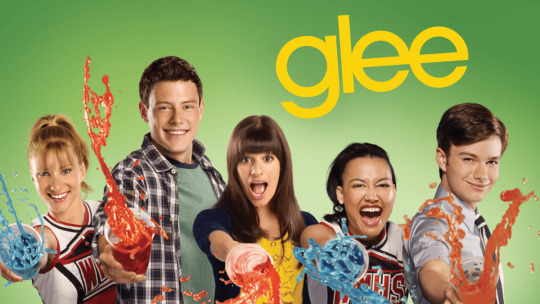
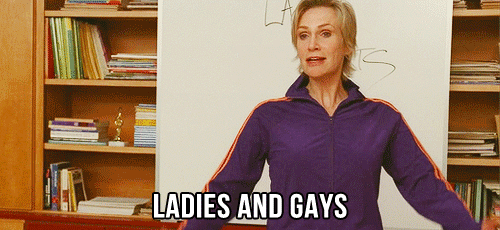
Oh dear. Where to even begin....
What we now know and love (or hate) as Glee began as a screenplay for a feature film of the same name by Ian Brennan. The screenplay then circulated to working TV writers Ryan Murphy and Brad Falchuk, and the three soon began writing a full television season based on Brennan's original screenplay. The series was very quickly picked up by FOX, following the success of another musical-themed program: American Idol.
So has been said about Glee in retrospect, from recent TikToks dissecting problematic moments in the show to a docuseries addressing speculations of dissent among castmates. While this has been interesting fodder to engage with online, I do feel that we have reached a collective memory of Glee that has strayed from the original tone and intention of the show. This is also thanks to the complete diversion the show took in its later seasons after new writers were hired and the show tried to keep up with its own rapidly growing popularity.

Glee’s initial charm was similar to the central appeal of American Idol: a glimmer of hope in a time of economic hardship through an underdog story. Underneath its surface-level wackiness and off-kilter dialogue, Glee was intended to be a tongue-in-cheek satire; a "postmodern musical" in the words of Ryan Murphy. Based in Ohio, its characters grapple with the ongoing economic recession and try to find hope and resilience in their downtrodden circumstances through the imaginative powers of the songs they sing. The show’s humor and central conflicts in its first season are largely derived from disputes from the “big guys” punching down on the “little guys.” In fact, the rivalry between optimistic Glee Club instructor Will Schuester and absolutely unhinged cheer coach Sue Sylvester can be read alongside the country’s broader economic battles.
The mention of these two crucial characters brings me to an analysis of the show in conversation with the arguments of Robynn Stillwell in her work “Dual-Focus Strategy in a Serial Narrative: Smash, Nashville, and the Television Musical Series.” For this analysis I will refer to the first and last episodes of Glee’s first season, titled “Pilot” and “Jouney to Regionals,” respectively, pulling some contextual elements from episodes in-between if needed.
Dual-Focus Narrative

A defining stylistic feature of an episode of Glee is its introductory monologue, in which a character provides a voiceover of their unique, hilarious perspectives on the events of the episode to come. Throughout the episode, other characters might also provide a voiceover monologue with contradictory opinions, or introduce the episode’s B-plot. It is through these little snippets of each character’s perspective that the show manages its large ensemble cast and creates an advanced version of Stillwell’s described “dual-focus” narrative, with a different dual pairing each episode. This ability to navigate the complex relationships between many characters is something that is unique to Glee’s episodic format, and likely could not be achieved in its fullest in a film or stage musical.
While the show’s “Pilot” sets up the central romances between Finn & Rachel and Will & Emma, these romantic pairings do not completely comprise the “dual-focus” of the episode. Instead, we are given voiceover sequences from Will Schuester, Rachel, and Finn such that the show is dually-focused on the lives of adults versus teenagers in a middle-American high school during the economic recession. In this way, Glee pokes fun at the triviality of high school popularity while also likening these struggles to the conflicts among the adult characters, such as budget cuts to faculty but an increased budget for athletics and Sue’s cheer team. In other words, the concept of an "underdog" is timeless and not age-specific. Through its strange satirical lens, Glee celebrates youth and is reliant on the notion of second-chances, evident though the name Will Schuester gives to his new Glee Club: New Directions.
Inevitable Couplings


In my opinion, the pilot of Glee has an absolutely top-tier set up for its romantic interests, the jock Finn Wolfhard and the geeky theater girl Rachel Berry. The show takes advantage of its musical framework, two characters are set up as opposites through their first ever songs before they even interact in the episode.
To audition for Will’s New Directions, Rachel sings “On My Own,” a musical theater song from Lesa Miserables. She introduces her song with a chipper, contrived introduction and her audition is polished with a clear, classically trained voice. Moments later, Finn’s voice is heard in a much less formal manner, as Will hears him singing in the shower (not even gonna touch that one). His voice is free and imperfect, singing a classic rock song he adored as a child. Through these musical scenes, Rachel and Finn are contrasted in every way, from their personalities to their apparent levels of vocal training to their style of song. The show relies on our instincts to assume that opposites attract without any lines explicitly hinting at the romance with these two characters, so when the two sing together in “Don’t Stop Believing” at the end of the episode (which literally made me cry), their voices complement one another well and there is palpable chemistry as the characters dance together gleefully.
youtube
youtube
I would also be remiss if I did not mention “Klaine,” the iconic romance between Kurt and Blaine that begins in season two. The show sets this romance up in a very similar way, as Kurt admires Blaine’s suave confidence in an accepting environment which contrasts the homophobic environment Kurt experiences at McKinley High. They are, again, musically opposite, as Blaine often sings pop songs with an entire Glee club of boys while Kurt often sings musical theater ballads alone. Still, these opposites are not as apparent as Finn and Rachel’s, and the show now expects us to anticipate a romance based heavily on the fact that these are the only two gay male characters in the show thus far. While this romance was quite groundbreaking for its time, the show was still able to maintain its mainstream popularity by applying heteronormative frameworks onto queer characters, much like the Western musical frameworks we discussed last week.
Musical Fantasies
youtube
youtube
Music is the heart of Glee, adding texture to an otherwise dull environment. As the show progresses musical numbers take many adventurous forms, with numbers outside the diegesis that replicate famous music videos to conversations through song that blur the lines of diegesis.
Even with all the flashiest numbers, I think nothing embodies the escapist quality of music in Glee more than its backstage numbers, where we watch the characters perform as their true selves. At the end of the Pilot, the original six Glee Club members perform “Don’t Stop Believin’” on their own after news of Mr. Schue’s departure from the position. Their singing and dancing is free and uninhibited as much of the secondary characters watch. Most importantly, the number inspires a lurking Mr. Schue to change his mind and continue instructing the club. Music functions within the narrative as a site of hope for characters in unfortunate situations.
Through this, the show also epitomizes its sense of neoliberal progressivism, ultimately suggesting that we can all come together and sing away our differences.

18 notes
·
View notes
Text
Roundtable Presentations 2: The Monkees, Episode 19, Find the Monkees

The Monkees (1966-1968) is a comedic sitcom with musical elements, follows the adventures of the real American rock band, The Monkees, as they navigate humorous and absurd situations while striving for success in the music industry. In episode 19, "Find the Monkees," the band's quest for recognition intensifies when they learn about a TV producer auditioning rock bands for his new show. Desperate for an invitation, they resort to unconventional methods, leading to comedic mishaps. Meanwhile, the producer becomes determined to locate a mystery band, resulting in unexpected outcomes.
How does the series use dual-focus narrative as a strategic storytelling tool beyond heteronormative romantic pairings?

In “Find the Monkees”, the series utilizes a dual-focus narrative free from heteronormative romantic pairing, particularly in the dynamic between television producer Hubbell Benson and the band, The Monkees. While the primary plot revolves around The Monkees humorous misadventures and attempts to gain recognition from Benson in order to get onto his new TV show. The subplot involves Benson’s frantic search for the mystery band, which is of course The Monkees, who he heard and wants for his show. The dual-focus narrative highlights both sides of the equation: Benson's persistent efforts to locate the band responsible for the captivating recording he heard, and The Monkees' unwitting involvement in Benson's search while pursuing their own aspirations. This narrative technique not only enhances the comedic elements of the episode but also underscores the interplay between the characters and their respective goals, ultimately driving the storyline forward.

The producer, Hubbell Benson.
What are the “inevitable” couplings within the series and how are they accentuated through “cinematic” similarities and contrasts?
In episode 19 the " inevitable” coupling is between the television producer Hubbell Benson and the four main characters – Davy, Mikey, Peter, and Mike– is emphasized through specific visual motifs, camera angles, and editing techniques. The producer is depicted in basic formal office attire, visually contrasting with the bright color and patterns of clothes worn by The Monkees. One similarity that they share is the red tie Hubbell wears and the bright red shirts of The Monkees. Red is a very prominent color in this episode.

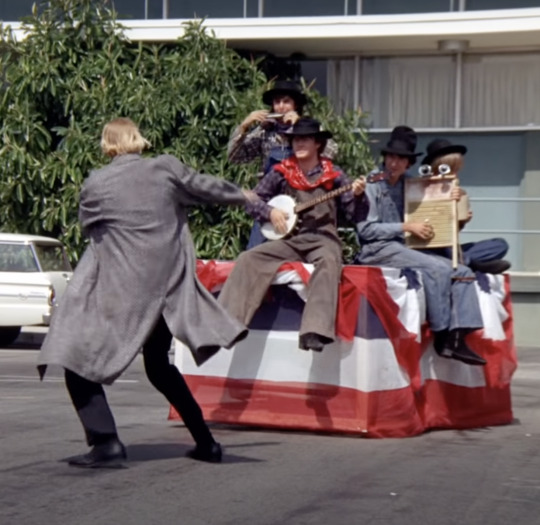
The attire of The Monkees helps with the comedic and whimsical tone of the show. Humorous editing techniques like jump Cuts or visual gags enhanced comedic moments, further accentuating the contrast between the professional producer and the amateurish main characters. These visual and technical elements contribute to the episode's comedic tension, the cat and mouse chase between the two.
How does the series use musical numbers within and beyond the narrative world to replicate fairy tale, backstage, or folk musicals?
It’s difficult to classify The Monkees' as a TV musical due to its deviation from conventional musical formats. While it bears resemblance to backstage musicals, it evades simple categorization by blending elements of comedy, musical, and television sitcom. Inspired by The Beatles' film "A Hard Day's Night," the series integrates musical performances seamlessly within its narrative. However, unlike typical jukebox musicals, the music serves as a promotional tool for the real-life band's albums rather than an integral part of the storyline. The band was formed for the television show and later left NBC to create their own music as a group, foregoing the fictional version of themselves. The on-screen musical scenes lack immersion, with evident dubbing of final tracks over the performance of “Sweet Young Thing”,
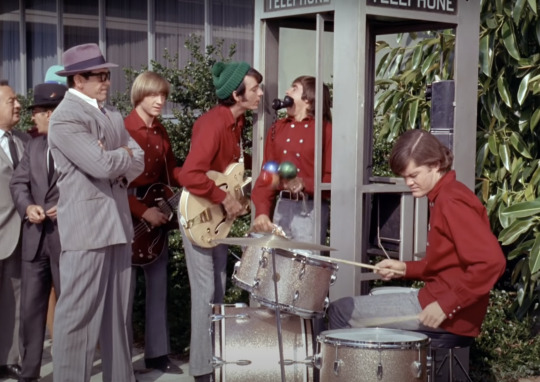
and montage sequences with no reality within the narrative of the show with shots of performances reminiscent of The Ed Sullivan Show as seen in the number “Papa Gene’s Blues”,
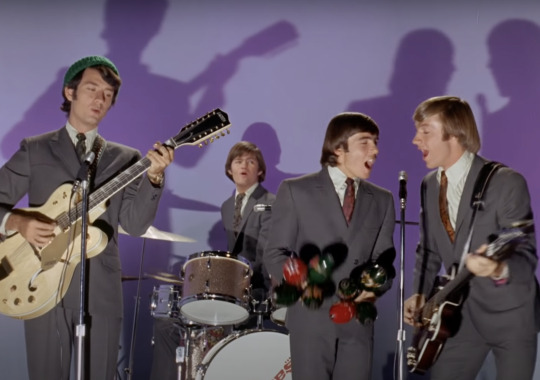
Yet, the narrative utilizes musical numbers to showcase the band's talent and appeal to potential viewers and buyers. Furthermore, the lengthy epilogue tag featuring an interview with the band and producer Robert Rafelson discussing real-life events adds another layer to the show's complexity. This blurred line between reality and fiction underscores the band's status as both performers and characters within the comedic sitcom setting, contributing to the show's unique status within this discussion.
youtube
16 notes
·
View notes
Text
Roundtable: Eli Stone
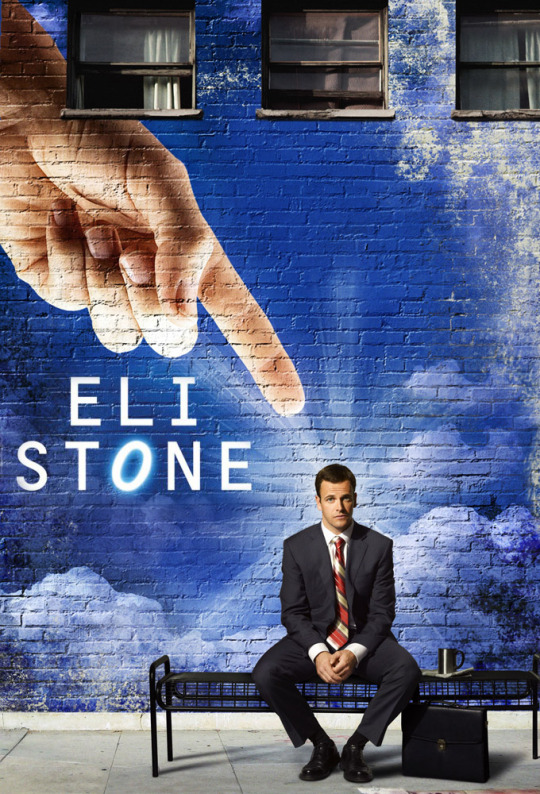
How does the series use dual-focus narrative as a strategic storytelling tool beyond heteronormative romantic pairings?
The series uses dual focus narrative through the perspective on Eli's brain aneurysm. Eli's brother, wife, boss, and assistant are all close to him and care about him. So, Eli is important to them in all different ways and he has different relationship with all of them. Therefore, when they receive the news, their responses are all different. The intrusion of the aneurysm forces different stories to be told about Eli's many relationships, outside of the obvious relationship with his fiancé. Eli's brother still keeps the relationship light hearted and toys to help him as he is a doctor. While Eli's assistant, Patti, sees the horrible news as a breakage of trust in their relationship because of their long term partnership in business. Also, the aneurysm puts Eli's relationship with his fiancé in jeopardy.
youtube
What are the “inevitable” couplings within the series and how are they accentuated through “cinematic” similarities and contrasts?
The inevitable couplings are shown through the similarities and contrasts between certain characters and those relationships. For example, Eli Stone being a hard working very successful lawyer is automatically coupled with a very beautiful fiancé. In terms of similarities, while at work, Eli is surrounded by lawyers that are just like him: masculine, leader-like men who boss each other around. Conversely: Eli's assistant is a black woman and one of the only prominent black characters. Additionally, Eli's Asian friend, Dr. Chen, is consistently bestowing wisdom upon him. Both these character parings say something about the narratives regarding marginalized stereotypes of working or wisdom.
youtube
How does the series use musical numbers within and beyond the narrative world to replicate fairy tale, backstage, or folk musicals?
The musical numbers are written into the narrative of Eli's delusion with his aneurysm. As Robyn Stilwell addresses, television musicals can be difficult because of the narrative structure. However, in this show with the jukebox component, Eli has delusional visions of performances of popular music. This works quite well. The first example of this is George Michael's "Faith". This urges, quite literally, for Eli to have faith, even while many strange things are happening to him. This structure of musical numbers doesn't relate to any of the above genres, but it provides an influence on Eli's character development.
youtube
14 notes
·
View notes
Text
Roundtable Presentation: The Musical Will Be Televised - Schmigadoon!
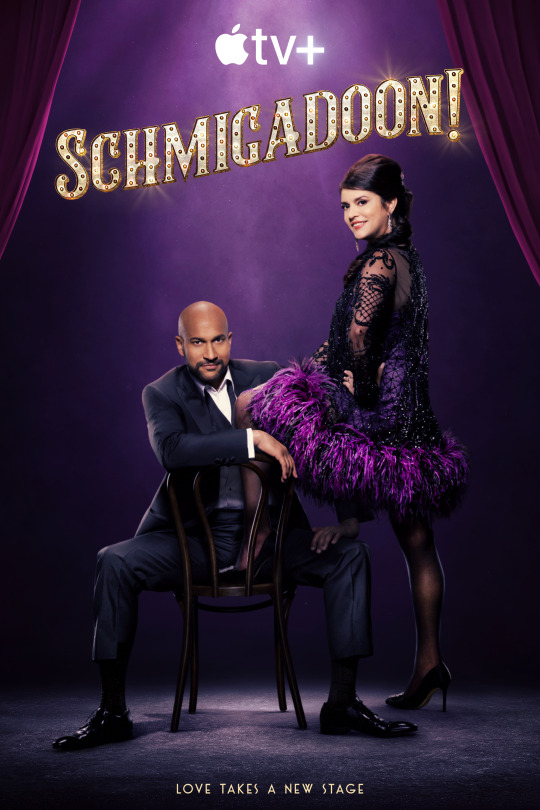
Schmigadoon! (Cinco Paul & Ken Duario) is a rom-com musical about two New York doctors attempting to strengthen their relationship, and get swept into a magical land (Schmigadoon) where everyday is a musical. The only way out of this magical land is to find true love.
How does the series use dual-focus narrative as a strategic storytelling tool beyond heteronormative romantic pairings?
Though the show is about a heteronormative romantic pairing (Melissa (Cecily Strong) and Josh (Keegan Micheal-Key)) who have been dating for four years, the show takes a bit of a turn that could possibly challenge this idea. In the first episode, they realize there must not be true love if they can't leave Schmigadoon, so they decide to breakup and find true love elsewhere. In this way, Melissa and Josh aren't portrayed as a romantic pairing, but as two people trying to learn about what it means to love separately.
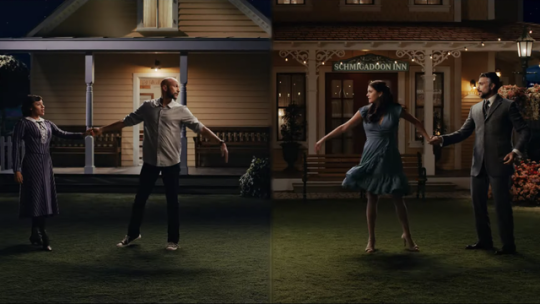
The two embark on their journeys to find love while they're trapped in Schmigadoon, their experiences parallel to one another in many ways. This part of the show made me think of Robynn Stilwell's article, “Dual-Focus Strategy in a Serial Narrative: Smash, Nashville, and the Television Musical Series", when they wrote, "The dramatic expositions are based on an alternation of male and female, complementary actions that make the characters’ meeting and eventual pairing seem “inevitable" (Stilwell 384). As the show is a musical we can expect, as the audience, that it will be a happy ending for Josh and Melissa. Their separation creates a time where they can learn about their true feelings for one another only after enduring the necessary events that will lead to their "eventual pairing".
What are the “inevitable” couplings within the series and how are they accentuated through “cinematic” similarities and contrasts?
In the first two episodes, there are two clear couples, Josh and Betsy (Dove Cameron), and Melissa and Danny (Aaron Tveit). These couples are "inevitable" in respect to the short term, as of course the long term inevitable is the reunion of Josh and Melissa.
In the first episode, Danny makes a comment upon Josh and Melissa's arrival in town about letting Melissa ride free in the Love Tunnel (a carnival ride), foreshadowing their eventual attraction to one another. This is furthered in the musical number, "You Can't Tame Me" sung by Danny that implies that she will in fact "tame" him. Later on in episode two, Melissa sings "Enjoy the Ride (Part I)" where she talks about having always played it safe with love, which contrasts with Danny's character being described as a bit of a "bad boy".
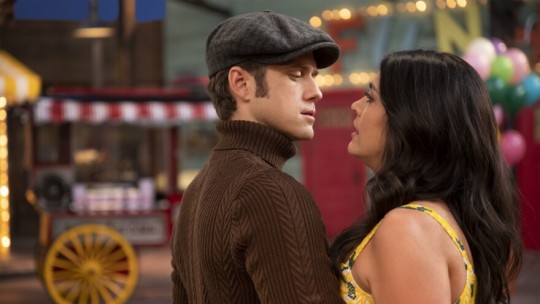
Josh and Betsy's coupling is first hinted at in the first episode when she laughs at something Josh says--that wasn't funny-- and strokes his arm while he and Melissa are ordering breakfast. In the second episode, after he and Melissa have broken up, Josh bids on Betsy's basket after she, quite seductively, insists that he do. Betsy's almost "temptress-like" character is heightened by the red color palette of her costume (bows, dress, lips, and nails). This is furthered in the musical number, "Enjoy the Ride (Part II)", where she sends mixed messages concerning her desires while on a picnic with Josh.
youtube
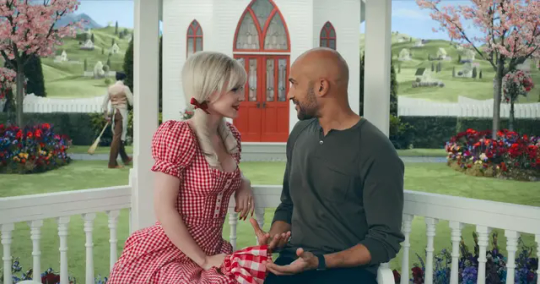
How does the series use musical numbers within and beyond the narrative world to replicate fairy tale, backstage, or folk musicals?
This series reminded me of fairy tale musicals and folk musicals. In fairy tale musicals we see common tropes such as the passive female waiting for her prince, and similarity we see this sort of manifest in Schmigadoon as well. The town of Schmigadoon is one that abides by the laws of God, and employs more traditional views on marriage and gender roles. For example, "Where a man can dream dreams so big and wide/And a gal can be ever by his side" are lyrics in the musical number "Schmigadoon!". From this song, we can get a better idea of the town's social structure.
However, the musical number "Somewhere Love is Waiting For You" sung by Mayor Menlove (Alan Cumming) challenges the fairy tale trope of female passivity. The songs talks about finding love, and pursuing it rather than waiting for it to happen to you.
youtube
As far as the show's similarity to folk tales, I thought it was especially reminiscent of white musicals. Not only is the plot focused on love and happiness outside of the workspace, but it also utilizes utopianism/escapism. At the beginning of the show, Josh and Melissa are shown at work, which is filmed with greyed and more dull colors and tones. They then leave the workspace, and enter a magical land very detached from the real world where they must find true love. In the song "Schmigadoon" shown below describes the town and how it is "the most beautiful, wonderful, magical place of all" where their motto "We always strive for peace and happiness". This follows the expectations of the white musical, as the two leads will eventually get their happy ending where something (true love) has been accomplished.
youtube
19 notes
·
View notes
Text
Crazy Ex-Girlfriend

How does the series use dual-focus narrative as a strategic storytelling tool beyond heteronormative romantic pairings?
Crazy Ex-Girlfriend uses dual-focus narrative to highlight rivalry rather than heteronormative romantic pairings. For example, Rebecca and Valencia are pitted against each other because they share a love interest. Their “rivalry” plays out through song even though they eventually become friends. Crazy Ex-Girlfriend’s dual focus narrative deviates from the typical heteronormative “marriage plot” because although the conflict appears to stem from the shared love interest, the real conflict is less about Josh and more about generalized feelings of comparison, inadequacy, and jealousy. This “parallelism” that Stilwell mentions allows for the focus to be placed on the women and their journey from enemies to friends, rather than the typical heteronormative romantic coupling. In fact, the article mentions that “the drive created by a rivalry offers greater scope for expansion in an open-ended narrative like a television series”. This scope has allowed Crazy Ex-Girlfriend to subvert expectations of the genre—a Vox article even mentions that the show is “a complete deconstruction of the marriage plot”.

What are the the "inevitable" couplings within the series and how are they accentuated through "cinematic" similarities and contrasts?
Some of the “inevitable” coupling established in the beginning of the show is Rebecca and Greg. Greg is friends with Josh, the main love interest. This kind of trope–Greg’s interest in Rebecca while she’s preoccupied with someone else–links them as the heterosexual pairing. Their literal similarities appear in the first episode when they learn they have similar difficult pasts and darker senses of humor. Cinematically, Rebecca and Greg are depicted as normal characters which helps create their chemistry, while Josh is almost always depicted in a dramatic, romanticized way to mirror Rebecca's imagination and perception of him. He is often lit with dramatic lighting or appears in slow motion with some sort of fog machine. This cinematic contrast between Greg and Josh, allows for a more obvious coupling between Rebecca and Greg.

How does the series use musical numbers within and beyond the narrative world to replicate fairy tale, backstage, or folk musicals?
Crazy Ex-Girlfriend uses costumes, over-the-top choreography, and showy sets to parody famous fairy tale, backstage, and folk musicals. The show visually references numbers like “Cell Block Tango” from Chicago and “Diamonds are a Girl’s Best Friend” from Gentlemen Prefer Blondes, but uses its own original music instead. These obvious references to famous musicals are established so that the show can subvert and critique the original narrative. For example, when Rebecca is in jail, the song “What’s Your Story” is used as an obvious musical reference to “Cell Block Tango”. The female inmates are costumed with black lingerie over their orange jumpsuits, calling attention to the original number’s unrealistic over sexualization. Rebecca begins singing and demands the same sensationalized stories from “Cell Block Tango” and is disappointed to hear stories that are more complicated, sad, and distressing. By referencing memorable musical numbers like this one, Crazy Ex-Girlfriend is able to call out problematic overgeneralizations and sexist stereotypes with humor and theatricality.

18 notes
·
View notes
Text
Panel Presentation: Big Time Rush (2009)
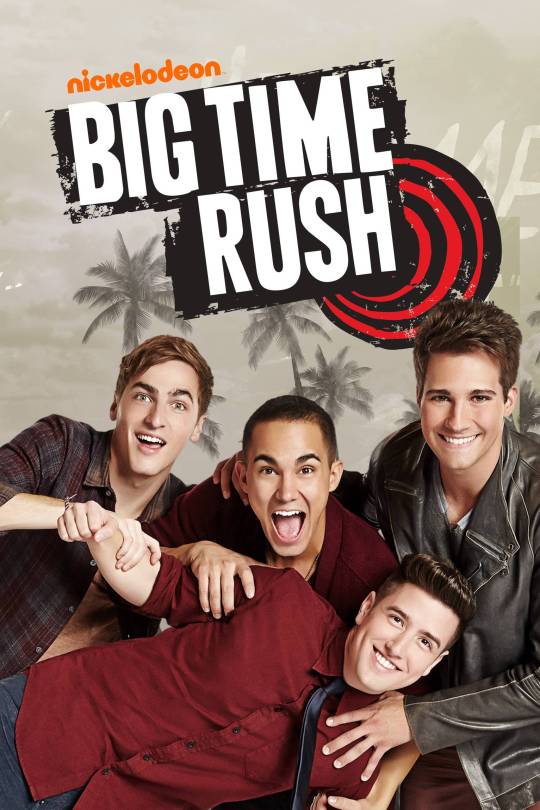
Nickelodeon’s TV series Big Time Rush follows the adventures of four hockey-playing best friends from Minnesota—Kendall, James, Carlos, and Logan (all named after their corresponding actors)—after they're selected to form a boy band. The show captures their humorous and often chaotic journey as they navigate the ups and downs of the music industry, fame, and friendship, all while trying to stay true to themselves and their roots. It's a blend of comedy, music, and the challenges of adolescence, set against the backdrop of their dream to become successful musicians.

How does the series use dual-focus narrative as a strategic storytelling tool beyond heteronormative romantic pairings?
Big Time Rush utilizes a dual-focus narrative in a way that extends beyond traditional heteronormative romantic pairings, similar to the examples of Smash and Nashville discussed in the article. Because Big Time Rush is focused on the band of friends (with occasional B plots featuring Kendall’s family), the focus of the series shifts from romantic relationships and applies the dual-focus narrative to explore themes of friendship, competition, and personal growth among the band members and their interactions with others. This strategy allows the show to address a broader range of relationships and conflicts, resonating with a wider audience by depicting varied forms of relationships and personal dynamics beyond the conventional romantic plotlines.
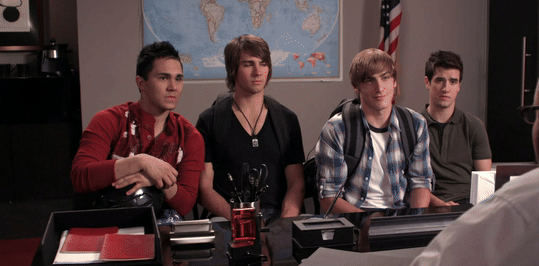
What are the “inevitable” couplings within the series and how are they accentuated through “cinematic” similarities and contrasts?
In Big Time Rush, "inevitable" couplings primarily highlight the evolving friendships and rivalries, not just fleeting romantic entanglements. The series employs cinematic techniques like strategic editing, emotive music, and parallel scene construction to enrich these dynamics. A prime example is the complex relationship between the band members and Gustavo Rocque, their producer. Their journey is marked by musical showdowns, dramatic conflicts, and heartfelt moments of unity, showcasing a spectrum of emotions that deepens the narrative. While the series does feature some romantic storylines—such as Kendall and Logan establishing significant relationships early on—these are not the sole focus. Instead, the series places a stronger emphasis on the bonds formed through shared struggles and triumphs in the music industry.
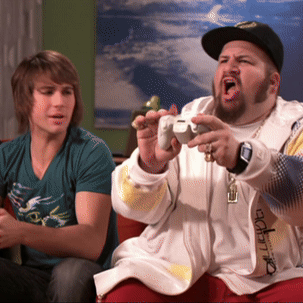
How does the series use musical numbers within and beyond the narrative world to replicate fairy tale, backstage, or folk musicals?
Big Time Rush leverages musical numbers to embody the essence of a backstage musical series, blurring the lines between the characters' real-life trials and their artistic expressions. Within the narrative world, the series uses these performances to delve into the personal and professional growth of the band members. Songs become a medium through which characters navigate the highs and lows of fame, friendship, and the music industry, offering viewers a glimpse into the creative process and the challenges of pursuing a career in entertainment. However, the musical numbers in Big Time Rush often go beyond the narrative, using the creation of these numbers as plot points in the series, giving the audience a sneak peek into the world of the music industry. This approach not only showcases the talents and hard work behind the scenes but also celebrates the communal joy of music. The series captures the spirit of backstage musicals by presenting a cohesive blend of storytelling and performance, where music acts as both a narrative force and a bridge connecting the characters with their audience.
youtube
Ultimately, Big Time Rush was created to capture the essence of the boy band phenomenon while appealing to a younger audience. Its inception was likely inspired by the success of real-life boy bands and the entertainment industry's interest in creating content that blends musical performances with narrative storytelling. The show aimed to entertain, of course, but also to inspire its audience with themes of friendship, perseverance, and the pursuit of dreams despite the odds. By showcasing the fictional journey of four hockey players turned pop stars, "Big Time Rush" tapped into the aspirational and relatable dreams of many viewers, offering both escapism and positive messages about hard work, loyalty, and creativity.
17 notes
·
View notes
Text
I think you did an effective job analyzing this show, as you explain the dynamics of character that are woven in reflection to the social/political message. I do question if it is possible to expand more on the musical aspect of the film in regards to cinematography and editing that is connected to the narrative?
Empire - Television Musical Roundtable
Empire is an American musical drama television series that centers around a hip-hop music conglomerate, offering viewers a compelling look at the industry's cutthroat nature. The show debuted on Fox in January 2015. At the heart of the series is the Lyon family, led by the formidable Lucious Lyon, a hip-hop mogul and the CEO of Empire Entertainment, and his ex-wife Cookie Lyon, whose release from prison adds further complexity to the narrative.
The series is well-known for its captivating blend of music and drama, with its musical aspect being one of its most distinctive features. The show integrates original songs and stunning performances into its storyline, showcasing the talents of its cast while exploring themes of ambition, power, family dynamics, and the American Dream. The series not only entertains but also provides a critical lens on issues such as race, sexuality, and the quest for success in the music industry. Over its run, Empire has received critical acclaim for its storytelling, character development, and especially its musical contributions, making it a groundbreaking series in the portrayal of the contemporary music scene.
youtube
How does the series use dual-focus narrative as a strategic storytelling tool beyond heteronormative romantic pairings?
As most successful television narratives do these days, Empire embraced the dual-focus narrative in constructing a dynamic storyline and plot landscape. Given the sizable cast, the narrative should more accurately be regarded as “multi-focus”. The nature of Empire being structured around a family unit offers a layer of complexity and opportunity for this narrative style seeing as, no matter what individual circumstances or experience each individual character is going through, they are all bound to regroup on common ground at some point. They are tied together, meaning their stories are constantly being intertwined and reframed within the greater context of their family and music organization. At one level, we witness the rivalry and dynamic between Lucious Lyon, as the CEO of Empire Entertainment (head of the family), and his ex-wife Cookie Lyon, who emerges from prison to claim her share of the company and place within the familial hierarchy. This rivalry extends beyond their failed marriage, exploring themes of power, redemption, and ambition. On another level, the series portrays the individual journeys of their three sons - Andre, Jamal, and Hakeem - each vying for control of the empire in their unique ways. Andre, the eldest, battles personal demons and seeks validation through his business acumen; Jamal, a talented musician, navigates his career while being openly gay in a genre not known for its acceptance; Hakeem, the youngest, grapples with his identity as an artist versus the legacy of his father's empire. Through these parallel narratives, Empire goes beyond simple romantic entanglements to explore deeper issues of familial loyalty, identity, and legacy within the cutthroat music industry.
youtube
2. What are the inevitable couplings within the series and how are they accentuated through "cinematic" similarities and contrasts?
Empire's "inevitable couplings" are focused through the various dynamics of family and power. As mentioned above, a prominent coupling is the tumultuous relationship between Lucious and Cookie Lyon. Their interactions are charged with a history of love, betrayal, and shared dreams, accentuated by their contrasting approaches to life and business; Lucious is cold, calculating, and often ruthless, whereas Cookie is fiery, passionate, and deeply loyal to her family. This contrast is visually represented in their styles (Lucious' refined suits versus Cookie's bold and extravagant outfits) and their interactions with the world around them (Lucious' command of boardrooms versus Cookie's hands-on approach with artists). Another significant coupling is between Jamal, the middle son who is an R&B sensation, and his music, which serves as his true partner. It’s an interesting point to note here that these couplings need not always be between people. Jamal’s coupling is not with a definitive person or concrete force. Rather, it is woven into his personal life through an abstract representation in the form of his songs, reflecting his struggles with his identity, his battles with his father's expectations, and his desires for love and acceptance. These narrative and visual contrasts highlight the tensions and harmonies within the Lyon family, driving the series' drama and emotional depth.
youtube
3. How does the series use musical numbers within and beyond the narrative world to replicate fairy tale, backstage, or folk musicals?
In Empire, musical numbers transcend mere performance, becoming a pivotal narrative device that reflects and influences the characters' arcs and the series' thematic underpinnings. The show replicates the essence of fairy tales, backstage dramas, and folk musicals by intertwining the characters' personal and professional lives with their musical creations. For example, Jamal Lyon's musical journey is emblematic of a fairy tale struggle, showcasing his rise from a doubted underdog to a celebrated artist, overcoming personal and societal challenges. His songs often serve as a narrative vehicle for expressing his innermost feelings and conflicts, particularly about his sexuality and family dynamics. Hakeem's performances, on the other hand (reminiscent of the backstage musical) celebrate the glamour and grit of the music industry, as well as explore the personal cost of fame and difficult family dynamics interwoven with power struggles. They are, in short terms, simpler and more literal. Through these musical numbers, Empire delves into the folklore of the modern music industry, presenting a dramatized portrayal of its challenges, triumphs, and the relentless pursuit of legacy. The series uses music to echo the characters' battles, dreams, and triumphs, making each song a chapter in the larger story of the Lyon dynasty. Additionally, the musical numbers can often serve as a direct recounting of either overall recurring issues, themes, or motifs, even going as far as to literally recite the events of the past season or recent episode. In some moments, these numbers are so “on the nose” it’s almost comical.
youtube
youtube
@theuncannyprofessoro
18 notes
·
View notes
Text
Queens (2021-2022) by Zahir McGhee

In Zahir McGhee's musical TV show, Queens (2021-2022), follows the story of four women in their 40s previously in a famous hip-hop group together, reuniting to regain fame. Throughout the first two episodes, we see the show rehashing their past and the changes of roles in each of their lives that creates individual hardship, but finding comfort and vulnerability within their group.
How does the series use dual-focus narrative as a strategic storytelling tool beyond heteronormative romantic pairings?
Throughout the first episode, we are shown each member of the group and their current situations outside of their past. Brianna, or Professor Sex, is a mother of five and recently caught her husband cheating on her with a student of his. On top of that, he was diagnosed with cancer and had to get surgery, leaving Brianna having to take care of him for the sake of her children. Jill, or Jill the Thrill, is struggling to find coexistence with her sexuality and religion, as she has been having an affair with a woman that she is in love with and is having a hard time confronting her husband. Naomi, or Xplicit Lyrics, continues to chase her dreams of making music whilst trying to balance being a present mother for her daughter. In connection is her past complicated relationship with the group’s manager, Eric, who chose to be with Valeria, or Butter Pecan.
youtube
At the end performance at the BET, the women performed for the first time on stage together since they broke up, as each of their rap parts were in regards to their personal and romantic relationships. The use of rap as a way to create both a powerful and vulnerable moment for them as friends and as women facing the hardships of their reality. Especially when rap and hip-hop is a male dominated genre, the women's ability to use rap as a way to gain control and power over their own bodies and terms of their own lives show themes of black femininity and the toxicity of the music industry towards women of color.
What are the “inevitable” couplings within the series and how are they accentuated through “cinematic” similarities and contrasts?
The use of flashbacks and song as a way to cinematically explain the relationships between characters is embedded throughout the series. Although there are romantic relationships in the show, the relationship between the women and their loved ones is stands out, as there connection instills a comfortable vulnerability within conversations had and through song.
youtube
Before the BET performance, Naomi sings a beautiful ballad in regards to her relationship with her daughter. But, this song expands to the women facing their issues through confrontation and self-reflection. Through editing, the song is paired with all the situations at hand using visuals that go along with the narrative and feelings of each character. Although this does not go along the traditional "inevitable" couple, this does show the strong connections of the women and their own journey of fully gaining independence from their controlling past.
How does the series use musical numbers within and beyond the narrative world to fairytale, backstage, and musical?
The film's modern time does not take away from the escaping reality that musicals give. The use of song, especially within Naomi who is still chasing her dreams of being a folk solo artist, but is faced with obstacles due to the sexist and racist environment of the music industry. After meeting with a label that denies her of being a star, she calls her daughter in disappointment of how the meeting went. Her daughter puts her in her place, expressing how Naomi's efforts expended her time with her daughter and if she gives up now there would have been no point of her absence.
youtube
After the call, Naomi goes to the label manager's house to prove that she is a star, as she covers the song "Wrecking Ball." The song is coupled with her daughter, who is at home, playing the song on piano and layover verses that give it an emotional and magical feel. Moreover, Brandy's acting showed a vulnerable performance that characterizes Naomi unbelievable talent and her cherishing relationship with her daughter. Vulnerability through song shows the nature of the musical and how it is connected to the character's feelings that is enhanced through performance and editing.
3 notes
·
View notes
Text
youtube
Captivating Cinematic Music: Elevate Your Visual Storytelling with Orchestral Scores by Dom Capuano Music Delve into the mesmerizing world of cinematic music and discover how orchestral scores can enhance the emotional impact of visual storytelling in films, games, and television. Uncover the power and beauty of orchestral music as a subset of cinematic music. #CinematicMusic #VisualStorytelling #OrchestralScores #EmotionalImpact #FilmScores #GameSoundtracks #TelevisionMusic #Multimedia #FilmMusic #OrchestralSound via YouTube https://www.youtube.com/watch?v=uzrJMLe2B4k
0 notes
Video
youtube
Nobody's Gonna Catch Me Now
by Kevin Johnston
#countrymuisc#bluegrass#syncmusic#filmmusic#televisionmusic#musicsupervisor#femaleempowerment#freedom#female empowerment
6 notes
·
View notes
Text
How can you expand more on the social aspects of the show, especially with heteronormativity and race in a young-adult show?
Roundtable 2: High School Musical: The Musical: The Series
"High School Musical: The Musical: The Series" follows a group of students at East High as they navigate the ups and downs of adolescence, friendships, and relationships, all while preparing to stage a production of "High School Musical" for their school theater program.

How does the series use dual-focus narrative as a strategic storytelling tool beyond heteronormative romantic pairings? and provide an example from one of the episode
"High School Musical: The Musical: The Series" explore a variety of themes, including identity, friendship, and non-heteronormative relationships, thus moving beyond traditional heteronormative romantic pairings.
youtube
One prominent example of how HSMTMTS utilizes its dual-focus narrative to move beyond heteronormative romantic pairings is the portrayal of the character Carlos and his relationship with Seb. Carlos, the choreographer of the musical, and Seb, who plays Sharpay in their production of "High School Musical," share a sweet, evolving relationship throughout the series. In Season 1, Episode 5 ("Homecoming"), their relationship takes center stage when Carlos asks Seb to the homecoming dance. This episode not only highlights their relationship but also delves into themes of acceptance and self-expression. The homecoming dance scenario is used to showcase the normalcy and beauty of their relationship, challenging traditional norms and stereotypes.
What are the “inevitable” couplings within the series and how are they accentuated through “cinematic” similarities and contrasts?
One of the most notable inevitable couplings is between Nini and Ricky, the series' central duo, whose relationship dynamics are reminiscent of Gabriella and Troy from the original "High School Musical" films. Their relationship is accentuated through various cinematic techniques, including musical numbers, parallel editing, and shared screen moments that highlight their chemistry and emotional connection.
In Season 1, the relationship between Nini and Ricky is a focal point, evolving from exes to friends to potentially more, mirroring the journey of Gabriella and Troy in the original films. This is particularly evident in episodes where their mutual feelings are explored through songs and performances, mirroring the way Gabriella and Troy express their feelings in the original movies.
youtube
A specific example can be found in the season finale, where Nini and Ricky finally confront their feelings for each other. The use of close-up shots, the emotional intensity of their dialogue, and the background music all serve to heighten the moment, making it reminiscent of key scenes between Gabriella and Troy. The cinematography employs a mix of tight close-ups and wide shots during their duet, highlighting their connection both as individuals and as a couple. The sequence contrasts their earlier interactions, where medium shots and separate frames might have emphasized their distance or conflict, showcasing their growth both individually and together.
How does the series use musical numbers within and beyond the narrative world to replicate fairy tale, backstage, or folk musicals?
The essence of a backstage musical lies in its focus on the creation and production of a show, providing a behind-the-scenes look at the performers' lives, both personally and professionally. "High School Musical: The Musical: The Series" is a quintessential example of a backstage musical, as its primary storyline revolves around the students of East High staging a production of "High School Musical."
Example: Season 1, Episode 5 - "Homecoming"
An episode that includes the backstage musical elements is Season 1, Episode 5, titled "Homecoming." In this episode, the preparations for the musical intersect with the personal lives of the students, particularly focusing on the homecoming dance. The episode expertly weaves together the on-stage and off-stage dramas, highlighting the personal growth and challenges faced by the characters.
One of the key moments is when Ricky decides to make a grand gesture to win Nini back, using the backdrop of the musical and the homecoming event as his stage. This blending of the personal with the performative underscores the series' backstage musical theme, as the lines between the characters' real lives and their roles in the musical blur. The episode uses musical numbers not just for entertainment but as a means for character expression and plot development, showcasing the transformative power of performance and the personal stakes involved in putting on a high school musical.
16 notes
·
View notes